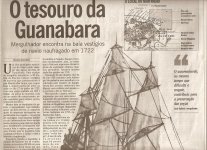hung
Sr. Member
- Jul 16, 2009
- 274
- 6
- Detector(s) used
- Tubedec A9000, Mineoro FG90, OKM Bionic X4
- Primary Interest:
- Other
Portuguese ship 'Rainha dos Anjos' sunken in the night of june 17th, 1722 was possibly found in Guanabara bay in Rio.
Brazilian divers led by Jose Galindo, found wood wrecks in the location they expected and were searching for years.
The cargo is estimated in US$ 1 billion and includes chinese porcelain from the Kangxi empire.
The pieces found were sent to analysis. Due to the mud present in the site, Galindo believes this acted to preserve the cargo.
Brazilian divers led by Jose Galindo, found wood wrecks in the location they expected and were searching for years.
The cargo is estimated in US$ 1 billion and includes chinese porcelain from the Kangxi empire.
The pieces found were sent to analysis. Due to the mud present in the site, Galindo believes this acted to preserve the cargo.




